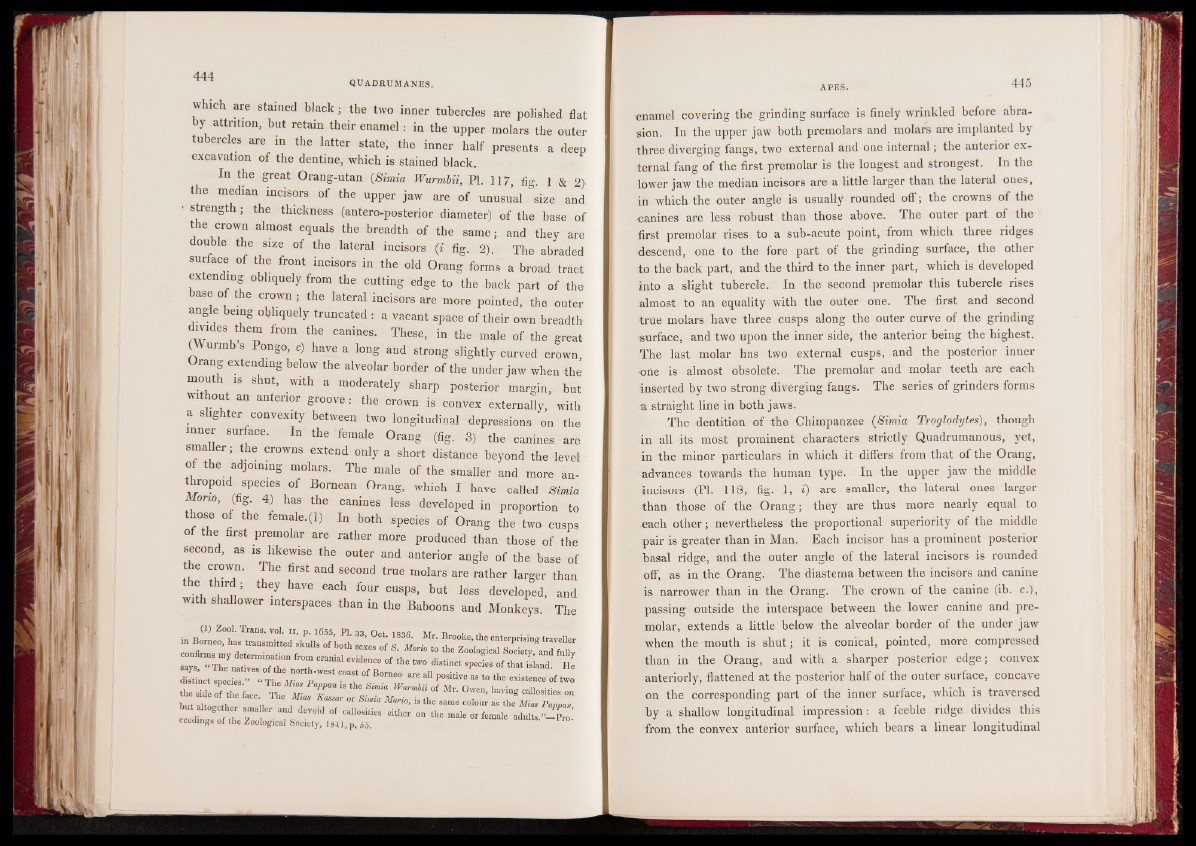
which are stained black j the two inner tubercles are polished flat
by attrition, but retain their enamel | in the upper molars the outer
tubercles are m the latter state, the inner half presents a deep
excavation of the dentine, which is stained black.
In the great Orang-utan (Simia Wurmbii, PI. 117, fig. 1 & 2)
the median incisors of the upper jaw are of unusual size and
• strength; the thickness (antero-posterior diameter) of the base of
the crown almost equals the breadth of the same; and they are
Qulde the size of the lateral incisors (i fig. 2). The abraded
surface of the front incisors in the old Orang forms a broad tract
extending obliquely from the cutting edge to the back part of the
base of the crown ; the lateral incisors are more pointed, the outer
angle being obliquely truncated : a vacant space of their own breadth
divides them from the canines. These, in the mjfie of the great
(Wurmb s Pongo, c) have a long and strong slightly curved crown,
Orang extending below the alveolar border of the under jaw when the
mouth is shut, with a moderately sharp posterior margin, but
without an anterior groove: the crown is convex externally, with
a slighter convexity between two longitudinal depressions on the
inner surface. In the 'female Orang (fig. 3) the canines are
smaller, the crowns extend only a short distance beyond the level
of the adjoining molars. The male of the smaller and more ani
T P / PeCieS °f B°rnean ° rang’ Which Mono, (fig 4) has the canines less develop1 edh aivne prcoaplloedrt ioSni mtioa
those of the female. (1) In both species of Orang the two cusps
of the first premolar are rather more produced than those of the
second, as is likewise the outer and anterior angle of the base of
the crown. The first and second true molars are rather larger than
e third; they have each four cusps, but less developed, and
with shallower interspaces than in the Baboons and Monkeys. The
XT(1)* Z oIofl. T—rans, vol. 11, p. 1•655, PI. 33 Oct 'isqfi Mi* n- «i .1. M E Lt S25SS7SE
stinct species. The Mias Pappan is the" Sf iBmiaB Wu 9rmb Iii o f Mr. Ow..e.n. Hhavi nHo- MiM 1i ■
ceedings of the Zoological SocieTy, ^ °“ male * female adults.”-Proenamel
covering the grinding surface is finely wrinkled before abrasion.
In the upper jaw both premolars and molars are implanted by
three diverging fangs, two external and one internal; the anterior external
fang of the first premolar is the longest and strongest. In the
lower jaw the median incisors are a little larger than the lateral ones,
in which the outer angle is usually rounded off; the crowns of the
canines are less robust than those above. The outer part of the
first premolar rises to a sub-acute point, from which three ridges
descend, one to the fore part of the grinding surface, the other
to the back part, and the third to the inner part, which is developed
into a slight tubercle. In the second premolar this tubercle rises
almost to an equality with the outer one. The first and second
true molars have three cusps along the outer curve of the grinding
surface, and two upon the inner side, the anterior being the highest.
The last molar has two external cusps, and the posterior inner
one is almost obsolete. The premolar and molar teeth are each
inserted by two strong diverging fangs. The series of grinders forms
a straight line in both jaws.
The dentition of the Chimpanzee (Simia Troglodytes), though
in all its most prominent characters strictly Quadrumanous, yet,
in the minor particulars in which it differs from that of the Orang,
advances towards the human type. In the upper jaw the middle
incisors (PI. 118, fig. 1, i) are smaller, the lateral ones larger
than those of the Orang; they are thus more nearly equal to
each other; nevertheless the proportional superiority of the middle
pair is greater than in Man. Each incisor has a prominent posterior
basal ridge, and the outer angle of the lateral incisors is rounded
off, as in the Orang. The diastema between the incisors and canine
is narrower than in the Orang. The crown of the canine (ib. c.),
passing outside the interspace between the lower canine and premolar,
extends a little below the alveolar border of the under jaw
when the mouth is shut; it is conical, pointed, more compressed
than in the Orang, and with a sharper posterior edge; convex
anteriorly, flattened at the posterior half of the outer surface, concave
on the corresponding part of the inner surface, which is traversed
by a shallow longitudinal impression: a feeble ridge divides this
from the convex anterior surface, which bears a linear longitudinal